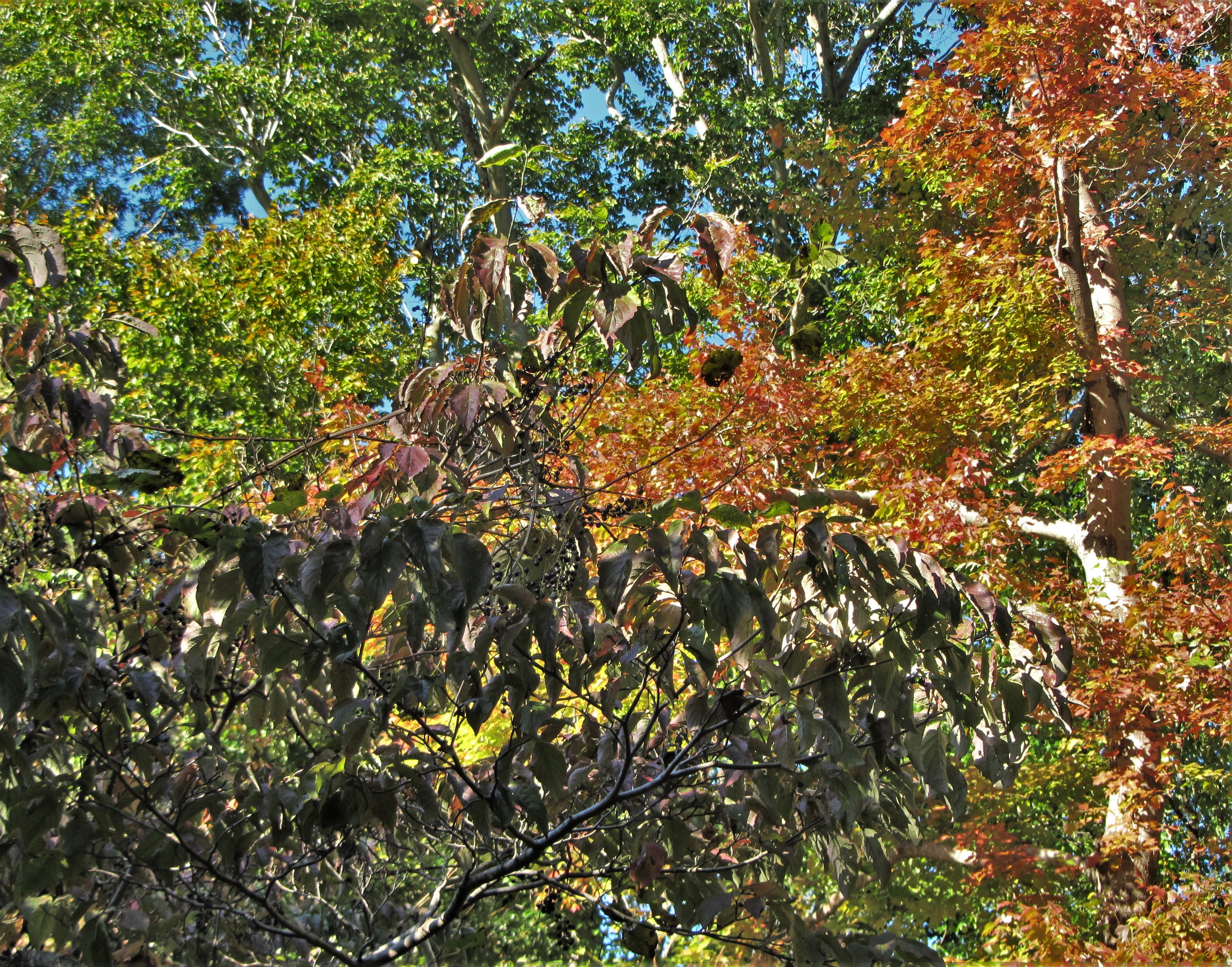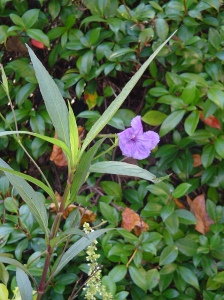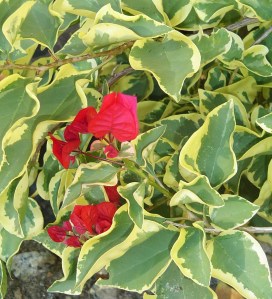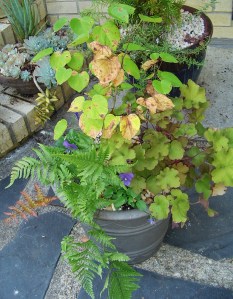
Camellia sasanqua opened its first flowers this week.
~
The wind swung around to blow from the north overnight as the rain finally moved off the coast. The cold front came on a wave of rain that moved in before my eyes opened at 5 Friday morning and hung around deep into the evening.
Today dawned clear and bright, crisp and chill. How rare to have a night in the 40s here, so early in October. But all that cleansing rain left a deep, sapphire sky to greet the sunrise.
The cold front caught me distracted this time. I didn’t plan ahead enough to start moving plants indoors last week. And so every Caladium and Begonia and Alocasia was left out in the soggy cold night to manage as best as possible.
~

Caladium ‘A Touch of Wine’ has been particularly cold tolerant this autumn.
~
Trying to make amends this morning, I began gathering our Caladiums, starting in the coolest part of the garden on the downhill slope behind the house. Pulling Caladium tubers out of heavy, waterlogged soil presents its own challenges. The only thing worse is leaving them in the cold wet soil to rot.
Timing out when to lift Caldiums can be as puzzling as when to plant them out in the spring. Some varieties signaled weeks ago that they were finishing for the season, by letting their stems go limp with their leaves fall to the ground. When that happens, you need to dig the tubers while the leaves remain to mark the spot. I’ve lost more than a few tubers by waiting too long to dig them, and forgetting where they were buried.
At the same time, other plants still look quite perky with new leaves coming on. It feels wrong to end their growth too soon, with those lovely leaves wilting in the crate. This is a time to prioritize which need immediate attention and which can grow on a while, yet. After tonight, we expect another warm spell, so I have an excuse.
~

Arum italicum remains dormant all summer, emerging again sometime in October.
~
Everywhere in our garden we see new plants coming out and blooming even as summer’s stars fade. If it weren’t for fall blooming Camellias, Arums, emerging bulbs and late blooming perennials, I couldn’t be so content in October. But in our garden there are always comings and goings, so I try to take autumn in stride.
The pot I planted last fall with Cyclamen hederifolium, Arum, and spring flowering bulbs has burst into new growth. Retrieving the few Caladiums I plopped in there in June was a bit of a challenge. I didn’t do too much damage, I hope, in pulling them up from between the Cyclamen that now are in full leaf. Cyclamen tubers are fun because they just grow broader and broader year to year, spreading into larger and larger patches of beautifully marked leaves and delicate flowers.
I’m finding seedpods on our Camellia shrubs even as the first fall flowers bloom. I’m working with Camellia seeds for the first time this year, after receiving a gift of Camellia sinensis seeds, the tea Camellia, from a gardening friend. Now that I know what to look for, I’m saving seeds from my own shrubs, too.
~

Pineapple Sage opened its first flowers this week beside a patch of goldenrod.
~
In fact, the garden is filled with seeds this week. I’ve harvested seeds from our red buckeye tree, acorns from the swamp chestnut oak, and Hibiscus seeds. I’m busily squirreling away the seeds in hopes many will germinate and grow into new plants that I can share.
Our birds are flocking in to enjoy the bright red dogwood seeds, along with beautyberry seeds and nuts from the beech tree. The drive is littered with beechnut husks and there are always birds and squirrels about. They are busy gathering all they can with birds swooping about the garden as I work. Even the tiny seeds I overlook, on the Buddleia shrubs and fading Black-eyed Susans entice the birds.
All the rapid changes feel dizzying sometimes. There is an excellent piece in today’s WaPo about the different autumn displays caused by climate change. Not only are species moving north and other new species moving in to replace them, but the very patterns of heat and cold and moisture are changing how the trees respond each fall. You may have noticed some trees whose leaves turned brown and fell weeks ago. Other trees still stand fully clothed in green. Forests once golden with chestnut leaves now show more scarlet and purple because of new species replacing the chestnuts last century.
~

Grapes ripen on the vines running through the dogwood tree. Color is slow to come this fall, with some trees dropping their leaves before they brighten.
~
Our red buckeye tree is native further to the south. But it is naturalizing now in coastal Virginia, and is growing very happily in our yard. Trees are very particular about how much heat or cold they can take, and how many chilling days they require in winter to set the next season’s buds. Most also dislike saturated soils. Our abundant rainfall, these last few years, has sent some trees into decline when the roots can’t ‘breathe.’
Trees are coming and going, too, just on a much grander scale. For every tree that falls, dozens of seedlings emerge to compete for its space.
I’m planting seeds this fall, starting woody cuttings, and starting a few cold weather bulbs and tubers. I have flats of Cyclamen and Arum started, and spent some happy hours this week tucking tiny bulbs into the earth, dreaming of spring flowers.
Changing seasons takes a span of many weeks in our garden. The day will soon be here when I start carrying pots indoors for winter. Other pots stay outside, replanted with flowers and foliage to fill them winter into spring. I need to stay focused on all of the comings and going- not let myself get distracted with the beauty of it all.
~

~
Woodland Gnome 2020
~

Hibiscus seeds are ripe for sowing.
~
Many thanks to the wonderful ‘Six on Saturday’ meme sponsored by The Propagator
Visit my other site, Illuminations, for a daily quotation and a photo of something beautiful.

















